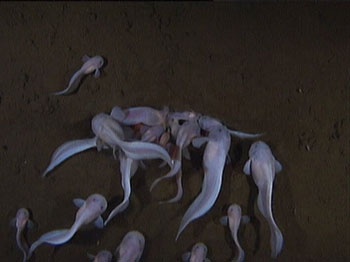The world’s deepest living fishes have been filmed for the first time.
Scientists filming in one of the world's deepest ocean trenches have found groups of highly sociable snailfish swarming over their bait, nearly five miles (7700 metres) beneath the surface of the Pacific Ocean. This is the first time cameras have been sent to this depth.
"We got some absolutely amazing footage from 7700 metres. More fish than we or anyone in the world would ever have thought possible at these depths," says project leader Dr Alan Jamieson of the University of Aberdeen's Oceanlab, on board the Japanese research ship the Hakuho-Maru.
"It's incredible. These videos vastly exceed all our expectations from this research. We thought the deepest fishes would be motionless, solitary, fragile individuals eking out an existence in a food-sparse environment," says Professor Monty Priede, director of Oceanlab.
"But these fish aren't loners. The images show groups that are sociable and active – possibly even families – feeding on little shrimp, yet living in one of the most extreme environments on Earth.
"All we've seen before of life at this depth have been shrivelled specimens in museums. Now we have an impression of how they move and what they do. Having seen them moving so fast, snailfish seems a complete misnomer," he added.
Although some species of snailfish live in shallow water and even rock pools, the hadal snailfish are found exclusively below 6000 metres. Here they have to contend with total darkness, near freezing temperatures and immense water pressure – at this depth the pressure is 8,000 tonnes per square metre, equivalent to that of 1600 elephants standing on the roof of a Mini car. They feed on the thousands of tiny shrimp-like creatures that scavenge the carcasses of dead fish and detritus reaching the ocean floor.
Hadal snailfish live only in trenches around the Pacific Ocean, with different species confined to each region: the Chile and Peru trenches off South America, the Kermadec and Tonga trenches situated between Samoa and New Zealand in the South Pacific, and trenches of the North-West Pacific including the Japan trench, which Priede's team is currently investigating.
The work is part of Oceanlab's HADEEP project - a collaborative research programme with the University of Tokyo - devised by Priede to investigate life in the hadal region of the ocean, which is anything below 6000 metres down. Program leader for the project is Professor Mutsumi Nishida, director of the Ocean Research Institute at the University of Tokyo.
The project has been funded by the Nippon Foundation in Japan since 2006 and by the Natural Environment Research Council since 2007. The latest cruise to the Japan Trench started on 24 September and ended yesterday, 6 October; it was organised by Dr Asako K. Matsumoto, HADEEP research manager. This particular cruise was funded by the Nippon Foundation, via the University of Tokyo.
The deep-sea equipment needed to survive the extreme pressure at these depths was designed and built by the Oceanlab team specifically for this mission. The submersible camera platforms, or 'landers', take five hours to reach the depths of the trenches and remain on the seafloor for two days before the signal is given for them to surface.
The team has been keeping an expedition blog, exclusive to Planet Earth online www.planetearth.nerc.ac.uk, a daily news site from the Natural Environment Research Council. The magazine website, which was launched last week, includes video footage and photographs of the expedition as well as blogs, podcasts, features and news.


